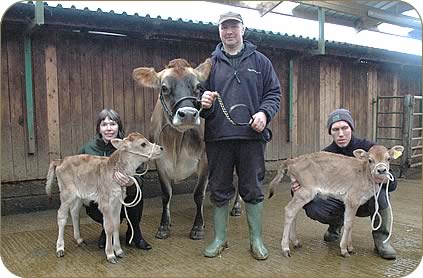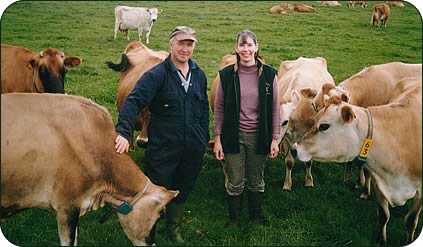 |
|||||||||
|
||||||||||||||||||||
| news index | Jerseys shaping the future at Abbott Lodge
Two articles in a Jersey Cattle Society magazine helped shape the future for Cumbrian dairy farming couple Steven and Claire Bland. Given the opportunity to make radical changes following foot and mouth, the Blands decided not to re-stock with black and whites but to go for pedigree Jerseys instead – and add value to the product by making and selling their own ice cream off the farm. Now, two years later the couple have no regrets about the decisions they made about their 230-acre tenanted farm, Abbott Lodge, at Clifton, near Penrith. The Jersey herd’s milk yields are competing well with those of black and white herds and 30,000 scoops of more than 30 different flavours of Jersey ice cream have been sold during 2004 to supplement the farm’s income. Chief tasters are the Blands’ son and daughter Robert, 15 and Elizabeth, 13!
The Blands took on the tenancy of the Lowther Estate farm in February 2000, attracted by the farm’s excellent grass growing ability. They were milking 140 black and white cows until foot and mouth struck the following year. They had already invested in a new milking parlour and bulk tank but wanted to avoid further investment – the cubicle shed was perfectly sound but the cubicles were suitable for smaller cows than today’s Holsteins. The articles in the Jersey magazine were on successful Cornish Jersey ice cream makers Roskilly’s and on Richard and Christine Tonks’ Jersey herd in Truro which was based on North American bloodlines.
Ironically, the Blands bought the Tonks’ Ventonwyn Jersey herd which subsequently came up for sale due to unforeseen tragic circumstances. And keen to add value to their product, Claire visited Roskilly’s who set her on the road to ice-cream making. “When I was at college I visited Anthony Pattinsons’ Calthwaite Hall and since then I always had a desire to milk Jerseys. We had already bought a Calthwaite cow – Sandys Vivien before foot and mouth,” said Steven. “The misconception about Jerseys is that they give 3,000 litres and they are cute little cows – but Jerseys can give 47 litres a day. Three from our herd’s last official recording were giving over 40 litres a day. “Our herd average on a butterfat and protein basis is just about the equivalent of a 13,000 litre black and white herd and a further advantage is the stocking rate of 1.5 cows to the acre for Jerseys and one cow for black and whites. The highest yielding Jersey herd in the UK is now doing more than 8,000 litres. “My bank manager handles the accounts of most of the Jersey farmers in the area and he didn’t say no when he heard our plans to re-stock with them.” To make up the herd along with the Ventonwyn cattle, Danish-type heifers from Arnold Thompson’s Farlam herd were also bought. Within a couple of years the Clifton herd has climbed into the Jersey breed’s top five per cent on performance, averaging 6,500 litres at 5.4 per cent butterfat and 3.9 per cent protein. The herd was runner-up in the breed society’s national herd awards 2004 and it includes the region’s top yielding Jersey cow at 9,543 litres at 5.4 per cent butterfat and 3.85 protein as well as the highest yielding Jersey heifer at 8,840 litres. The herd’s heifer average last year was 6,188 litres which would be an enviable yield for many black and white herds. The herd is likely to have its first 10,000 litre cow in the next few months. And Steven will continue to improve yields provided butterfat and protein are not sacrificed. If butterfat stays above five per cent and protein at its current level he will be satisfied. Problems such as difficulties with calving, retained cleansings and lameness are a thing of the past. But the biggest challenge with Jerseys is putting sufficient energy into their diet. Jersey dry matter intakes are high with them consuming on average five per cent of their body weight compared with 3.5 per cent for Holsteins. As a result, first cut silage is made later in May to increase its fibre content and increase activity in the rumen and wholecrop is also incorporated into the total mixed ration at 19 per cent protein. The rumen protected fat Megalac is also included. The cows are split into high and low yielders and are topped up in the parlour with a 21 per cent protein concentrate. At grass, the herd is set-stocked and buffer fed which Steven says is essential for high yielding Jerseys which are prone to metabolic and digestive disorders. Minerals and vitamins are also fed through water supplies. Little research has been carried out into Jersey dietary requirements in the UK. “The Americans know how to feed Jerseys and that is how they can get such high yields but a lot of it is trial and error in this country. The Clifton herd has reached its optimum number of cows at 140 which at the higher stocking rate has enabled the farm to be self sufficient in grazed grass and grass silage with an extra 32 acres now growing barley. But the Blands are continuing to look to North America for bloodlines to improve their herd. They are working closely with the semen company Jisex run by president of the Jersey Island cattle society Derrick Frigott importing semen from new North American bulls including Bomber, Sultan, Brazo and Ringmaster. They are also using a society bull called Schultz Brook Hallmark. A limited amount of embryo transfer work is carried out to improve the herd and establish cow families. When available, surplus heifers from the herd will be sold.
Once the Jersey herd was settled in, the Blands set about converting former calf pens an a former gin case – a circular horse engine house – on the farm for the ice cream making area and café with the help of a Defra grant. Claire makes more than 30 different flavours of ice cream herself, making it fresh and on a daily basis when there is big demand. Ice cream sales, which are made by the scoop into either individual cones or take-home packs, have doubled to 30,000 in two years. Without the added-value income from the ice cream the Blands would have had to milk 200 Jerseys and it gives the business another facet. While they are currently run as one business, each has to make money. “During the winter when we don’t have such high sales of ice cream, the milk price is at its highest then the ice cream sales pick up in the spring when the milk price drops. They complement each other,” said Claire. As well as the tea room and meeting room there is an outdoor play area and an indoor one is planned. Visitors to the farm can see the cattle grazing in the fields during the summer and see the calves. Steven and Claire are only too willing to explain all about farming to the general public and give slide shows of what happens on the farm. They have also done their bit for the environment through the Countryside Stewardship Scheme, of which they are now in their fifth year, having restored 7,000 metres of hedging and fencing, dug a pond which can be seen from the tea room and planted 50 trees. © Copyright 2005 Jennifer MacKenzie All Rights Reserved. |
|||||||||||||||||||

|
|
|||||||||||||||||||
| home | agri-services | pedigree
pen | news | dairy | beef | machinery bps | property | organisations | site map |
||||||||||||||||||||

Article by
Jennifer MacKenzie





